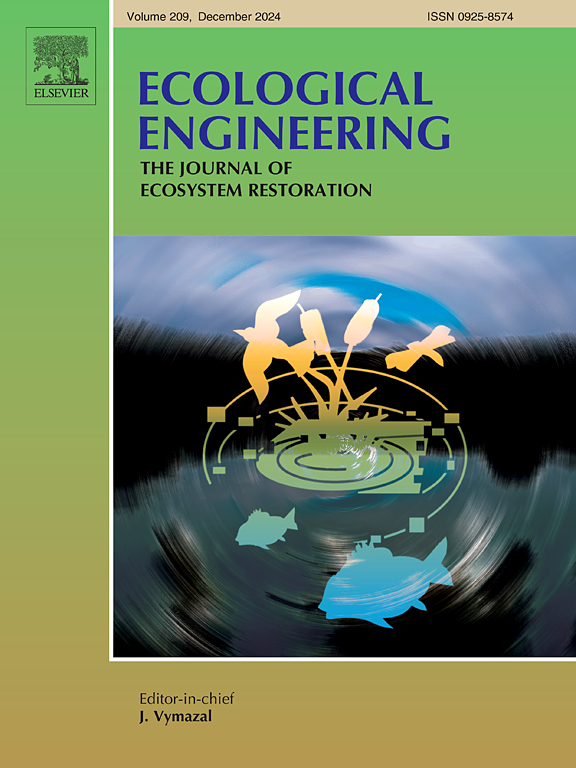Seaweed extract and biological fertilizer to stimulate the growth of Khaya senegalensis irrigated with agricultural drainage water in greenhouse conditions for a sustainable forest plantation industry in Northern Egypt
IF 3.9
2区 环境科学与生态学
Q1 ECOLOGY
引用次数: 0
Abstract
Due to the global deficiency in water, alternate water sources, such as agricultural drainage water (ADW), are now used to irrigate plants, particularly timber trees. A greenhouse experiment was carried out to assess the effects of irrigation schedules using ADW with or without Nile water (NW) on the growth of Khaya senegalensis seedlings. Additionally, the effects of mineral fertilizer (NPK) contains urea (46 % N), superphosphate (15.5 % P2O5), and potassium sulfate (50 % K2O) at a dose of 1 g N, 0.5 g P2O5, 0.5 g K2O/plant, seaweed extract (SE) at 7 mL/L from a commercial wild brown seaweed, Sargassum, and a biofertilizer Top Strains (TS)® at 30 mL/plant, as well as their combination on growth parameters of K. senegalensis seedlings were assessed. The plants that were irrigated with 100 % NW and fertilized with NPK + SE displayed the highest values in terms of shoot height (134.6 cm), leaf dry weight (123.28 g), stem dry weight (122.005 g), root dry weight (131.84 g), total dry weight (377.138 g), shoot/root ratio (1.858), shoot growth rate (4.53 cm/month), leaf area (447.176 cm2), leaf length (39.32 cm), number of leaves/plant (70.2), and number of leaflets/leaf (17). The plants irrigated with 100 % ADW and fertilized with NPK + SE had the highest chlorophyll content (57.159 SPAD units), followed by those irrigated with 50 % NW + 50 % ADW. The biomass production of K. senegalensis was moderately affected by the biofertilizer Top Strains (TS)®. The SE was subjected to chemical analysis using GC–MS, HPLC, and amino acid analyzers revealing the presence of several bioactive compounds. These included benzyl salicylate, oleic acid methyl ester, protocatechuic acid, pyrogallol, and benzoic acid, as well as the amino acids ammonia, alanine, glycine, and lysine, and the water-soluble vitamins thiamine and riboflavin. The biomass production from K. senegalensis was somewhat affected by adding SE, TS, or NPK fertilizers with irrigation regimes. Significantly, when K. senegalensis plants received irrigation with 100 % NW + 50 % ADW and treated with NPK + SE, most of their vegetative characteristics improved. The results have proved that fertilizer treatments and alternative water regimes are environmentally friendly and have economic applications to maximize the growth and yield of K. senegalensis.
求助全文
约1分钟内获得全文
求助全文
来源期刊

Ecological Engineering
环境科学-工程:环境
CiteScore
8.00
自引率
5.30%
发文量
293
审稿时长
57 days
期刊介绍:
Ecological engineering has been defined as the design of ecosystems for the mutual benefit of humans and nature. The journal is meant for ecologists who, because of their research interests or occupation, are involved in designing, monitoring, or restoring ecosystems, and can serve as a bridge between ecologists and engineers.
Specific topics covered in the journal include: habitat reconstruction; ecotechnology; synthetic ecology; bioengineering; restoration ecology; ecology conservation; ecosystem rehabilitation; stream and river restoration; reclamation ecology; non-renewable resource conservation. Descriptions of specific applications of ecological engineering are acceptable only when situated within context of adding novelty to current research and emphasizing ecosystem restoration. We do not accept purely descriptive reports on ecosystem structures (such as vegetation surveys), purely physical assessment of materials that can be used for ecological restoration, small-model studies carried out in the laboratory or greenhouse with artificial (waste)water or crop studies, or case studies on conventional wastewater treatment and eutrophication that do not offer an ecosystem restoration approach within the paper.
 求助内容:
求助内容: 应助结果提醒方式:
应助结果提醒方式:


